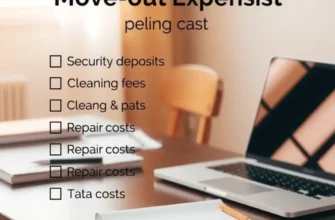Navigating the lease signing process can be both exciting and daunting, especially for young professionals, first-time renters, students, couples, and families. Understanding your financial obligations before you sign on the dotted line is critical to ensuring a smooth rental experience. With various components involved—such as deposits, monthly rent, and hidden fees—having a clear checklist can help you avoid common pitfalls and misunderstandings. This guide provides practical insights into the essential financial aspects to consider when signing a lease, empowering you to make informed decisions. From budgeting your initial costs to understanding ongoing expenses, you’ll find invaluable tips designed to put you on the right path as you embark on this new chapter in your life. Secure your financial peace of mind while finding your perfect place to call home.
Understanding Your Initial Costs

Before signing a lease, gaining clarity on your initial financial responsibilities is essential to avoid unexpected stress. Here’s a breakdown of potential expenses to expect as a first-time renter.
First, security deposits are a common requirement. Landlords typically ask for a deposit to cover any potential damages beyond normal wear and tear. This amount usually equals one month’s rent, but it can be higher, especially if you lack a rental history or have a lower credit score. Be prepared to pay this upfront, alongside your first month’s rent.
The first month’s rent is typically due when you sign the lease. This means you need to budget for two significant payments at once. Make sure your bank account can comfortably accommodate these expenditures to sidestep financial strain.
Application fees are another essential cost. These non-refundable fees cover administrative costs and background checks the landlord conducts. They range from $20 to $100 per application and depend on the location and rental market.
An important factor influencing these costs is your credit check. Landlords often perform credit checks to assess your reliability in making regular payments. A higher credit score can sometimes result in better terms, such as a lower security deposit. It might be beneficial to review tips on improving your credit score before applying for rentals.
To manage these initial costs effectively, draft a preliminary budget. Start by listing your monthly income and regular expenses, then account for upfront lease obligations. Ensure you have funds set aside for these initial payments and keep an emergency reserve for unexpected expenses.
Understanding the full scope of these initial costs can help ensure you step confidently into your new rental, reducing stress and avoiding potential credit issues. Preparation is crucial—not just for initial lease expenses but for fostering a sustainable financial lifestyle as a renter.
Ongoing Financial Obligations Beyond Rent

Signing a lease is only the beginning of your financial responsibility. Understanding the recurring expenses beyond rent is essential for financial stability. These include utilities, maintenance costs, and renter’s insurance. Preparing for these expenses ensures you can manage your finances effectively once you move in.
1. Monthly Rent
Your rent is your primary financial obligation. It’s essential to pay it on time to maintain a good relationship with your landlord and avoid late fees. Set up reminders or automate payments to ensure prompt payment.
2. Utilities
Utilities can significantly affect your monthly expenses. These typically include electricity, gas, water, and trash services. In some cases, your rent might cover certain utilities, so review your lease carefully. To estimate utilities, consider your lifestyle—do you use heating or air conditioning frequently? Are you often at home? This apartment organization guide might help manage your space efficiently, potentially reducing energy use.
3. Maintenance Costs
While landlords typically handle major repairs, renters are often responsible for minor maintenance, such as changing lightbulbs or replacing filters. Budget for these small expenses. Also, know your landlord’s policy on appliance repairs or larger maintenance issues to avoid unexpected costs.
4. Renter’s Insurance
Renter’s insurance is an underrated but crucial investment. It covers your personal belongings in the event of theft, fire, or natural disasters. Policies can be found for as low as a few dollars a month, offering peace of mind. Make sure it includes liability protection, which can be invaluable if an accident occurs in your apartment.
Estimating and Managing Costs
To maintain financial control, create a budget including all rent-related expenses. Track your spending for the first few months to adjust your budget as needed. Start by listing all predictable costs, like rent and insurance. For utilities, check historical usage if possible, or ask your landlord or neighbors for estimates.
Conclusion
Being prepared for ongoing financial obligations ensures a smooth renting experience. By accurately estimating and planning for these expenses, you can focus on enjoying your new home without stress. Remember to review your lease agreement thoroughly, so you’re aware of all your responsibilities and included services. Arm yourself with this knowledge to stay ahead of your financial commitments.
Final words
Moving into a new place should bring joy, not anxiety about financial responsibilities. Armed with this financial checklist, young professionals, students, couples, and families can approach the lease signing process with confidence and clarity. By thoroughly understanding both initial costs and ongoing obligations, you’ll be well-equipped to navigate the rental landscape and secure a home that truly fits your needs and budget. Take the time to prepare and stay informed, and you’ll find that renting can be a positive and rewarding experience.









